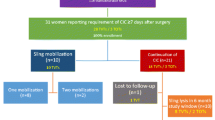Abstract
Introduction and hypothesis
A subset of neurologically normal females void by efficient Valsalva, not detrusor contraction. We determined the incidence of urinary retention following midurethral sling (MUS) placement in women that void by detrusor contraction versus Valsalva.
Methods
Review of patients undergoing MUS insertion between 2002 and 2009 for urodynamic stress incontinence was performed. Women with concomitant pelvic surgery, previous incontinence surgery, or preoperative incomplete bladder emptying were excluded. Patients were divided into two cohorts based on preoperative urodynamic findings—those that voided with a detrusor contraction >10 cm of water and those that voided by Valsalva.
Results
One hundred seven patients were available for analysis. The postoperative urinary retention rate was 22% and 5% in the Valsalva and non-Valsalva groups, respectively (p < 0.05). Mean retention duration was 3 weeks for each cohort (range 1–6).
Conclusions
Women voiding by Valsalva are at increased risk of urinary retention following MUS placement.
Similar content being viewed by others
Abbreviations
- MUS:
-
Midurethral sling
- SUI:
-
Stress urinary incontinence
- PVR:
-
Postvoid residual
- VLPP:
-
Valsalva leak point pressure
- PdetQmax:
-
Voiding detrusor pressure at maximum urine flow
- PTFE:
-
Polytetrafluoroethylene
References
Petros P, Ulmsten U (1995) Intravaginal slingplasty. An ambulatory surgical procedure for treatment of female urinary stress incontinence. Scand J Urol Nephrol 29:75–82
Morey AF, Medendorp AR, Noller MW et al (2006) Transobturator versus transabdominal mid urethral slings: a multi-institutional comparison of obstructive voiding complications. J Urol 175:1014–1017
Paick J, Cho MC, Oh S et al (2007) Factors influencing the outcome of mid urethral sling procedures for female urinary incontinence. J Urol 178:985–989
Charalambous S, Touloupidis S, Fatles G et al (2008) Transvaginal versus transobturator approach for synthetic sling placement in patients with stress urinary incontinence. Int Urogynecol J 19:357–360
Jones R, Abrams P, Hilton P et al (2010) Risk of tape-related complications after TVT is at least 4%. Neurourol Urodyn 29:40–41
Klutke C, Siegel S, Carlin B et al (2001) Urinary retention after tension-free vaginal tape procedure: incidence and treatment. Urology 58:697–701
Barron KI, Savageau JA, Young SB et al (2006) Prediction of successful voiding immediately after outpatient mid-urethral sling. Int Urogynecol J 17:570–575
Meschia M, Bertozzi R, Pifarotti P et al (2007) Peri-operative morbidity and early results of a randomized trial comparing TVT and TVT-O. Int Urogynecol J 18:1257–1261
Miller ER (1996) Physiology of the lower urinary tract. Urol Clin N Am 23:171–176
Bhatia NN, Bergman A (1984) Urodynamic predictability of voiding following incontinence surgery. Obstet Gynecol 63:85–91
Miller EA, Amundsen CL, Toh KL et al (2003) Preoperative urodynamic evaluation may predict voiding dysfunction in women undergoing pubovaginal sling. J Urol 169:2234–2237
Debodinance P, Delporte P, Engrand JB et al (2002) Tension-free vaginal tape (TVT) in the treatment of urinary stress incontinence: 3 years experience involving 256 operations. Eur J Obstet Gynecol Reprod Biol 105:49–58
Weinberger MW, Ostergard DR (1996) Postoperative catheterization, urinary retention, and permanent voiding dysfunction after polytetrafluoroethylene suburethral sling placement. Obstet Gynecol 87:50–54
Lemack GE, Krauss S, Litman H et al (2008) Normal preoperative urodynamic testing does not predict voiding dysfunction after Burch colposuspension versus pubovaginal sling. J Urol 189:2076–2080
Duckett JR, Patil A, Papanikolaou NS (2008) Predicting early voiding dysfunction after tension-free vaginal tape. J Obstet Gynaecol 28:89–92
Wheeler TL, Richter HE, Greer WJ et al (2008) Predictors of success with postoperative voiding trials after a mid urethral sling procedure. J Urol 179:600–604
Salin A, Conquy S, Elie C et al (2007) Identification of risk factors for voiding dysfunction following TVT placement. Eur Urol 51:782–787
Acknowledgments
None
Funding
None
Conflicts of interest
None.
Author information
Authors and Affiliations
Corresponding author
Rights and permissions
About this article
Cite this article
Pham, K.N., Topp, N., Guralnick, M.L. et al. Preoperative Valsalva voiding increases the risk of urinary retention after midurethral sling placement. Int Urogynecol J 21, 1243–1246 (2010). https://doi.org/10.1007/s00192-010-1177-2
Received:
Accepted:
Published:
Issue Date:
DOI: https://doi.org/10.1007/s00192-010-1177-2




